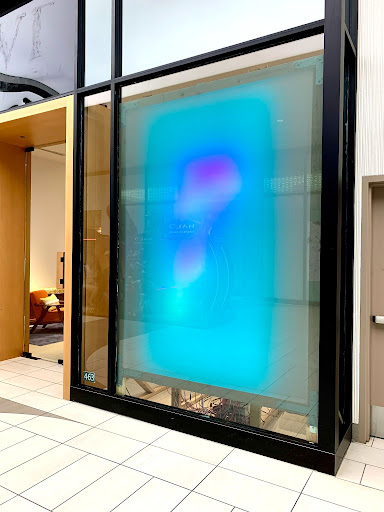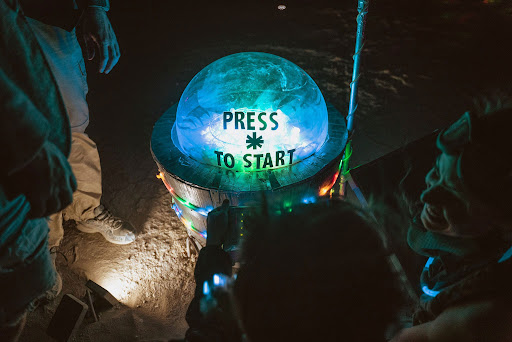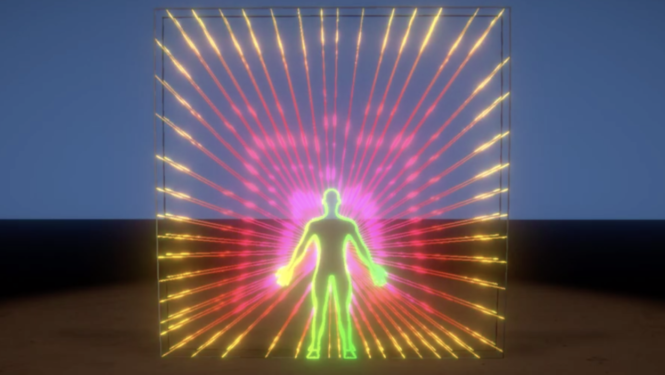With the 2021 Virtual Burn happening now (yes, right now…check it out!), it seemed fitting for us to highlight one of our Honorarium artists whose work incorporates technology and is accessible in virtual as well as physical spaces. We interviewed Matthew Pagoaga, an artist, technologist, and 2020/2021 Honorarium recipient. His Honorarium project, Parallel Self Embraced, was proposed prior to the COVID-19 pandemic and incorporates sensor-controlled LED lighting triggered by two participants embracing in the center of the structure.
This blog is the second in our new series “Art No Matter What,” highlighting what our 2020/2021 Honoraria artists are creating out in the world.
So, where can we find your art this summer?
Matthew: I’ve partnered with the Torrance Art Museum here in Southern California for several initiatives, and have had a couple other exhibitions and projects going. I was fortunate this year to be selected as a featured artist in the MOZAIK Future Art Awards. The virtual exhibition (which is up currently) is titled “Re-Imagining Democracy” and features work that elicits commentary on the current and future state of US democratic values. The art selected runs a wide gamut of mediums, topics, and perspectives. My work in the show, Pop Song, is an installation that uses gun violence data and toy pop-gun caps to represent, in near real-time, every injury or death occurring from gun violence nationally.

The second project I’m involved in this summer, Ultra!, features my work among 20 other artists via a public art exhibition spread around the city of Torrance. My piece, titled Lumia Learning is an adaptive LED piece framed on the work of pioneer light and space artist Thomas Wilfred, who, in 1940, surveyed viewers of his work to try to find the ‘ideal’ form of light — the colors and shapes that had the broadest appeal. In Lumia Learning, 4,000+ LEDs project abstract patterns onto a rear projection screen in an empty storefront window. A Kinect sensor tracks persons as they approach and view the piece. Lumia Learning then attempts to learn what forms and colors hold the most attention to the viewer and change itself to be the most ‘ideal.’ The hope is that the work points to internet democratization of art and the role social media and technology plays in curating and elevating the art work that we currently see. Measured by likes, clicks, and views, we have become a culture that streamlines popular opinion and highlights that which is most widely viewed. Lumia Learning aims to probe this in an even more extreme fashion, by having the work itself be one in flux, constantly tempered and changed by the viewership of itself. Ultra! runs until August 28th, and also features my works Pop Song and Myself When I am Not Real in the Torrance Art Museum gallery.
The third exhibition, NOMAD, also through the Torrance Art Museum, will take place just after Ultra! on August 28 – 29th in an empty five-floor office building in Torrance, California. Over 500 artists are participating and it should be an amazing couple of days. I’ll be debuting a new installation in NOMAD titled Trust.
What are your plans for “Parallel Self Embraced”?
In the short term, Parallel Self Embraced can be seen and experienced virtually in the Dusty Multiverse. I worked with Dusty Multiverse last year on getting the piece into their platform, and with the in-person event in the desert called off this year, we’re going to keep it going in there, virtually. Longer term, I still hope to make the physical piece for Burning Man in 2022. Having made Lumia Learning using a lot of the same technology and research I was going to do for Parallel Self Embraced, I think a lot of the tech can simply be replicated over into the new piece and brought out there on playa.
What year did you first attend Burning Man, and what was your first year bringing art to the playa?
I first attended Burning Man in 2010: “Metropolis.” It was one of the best weeks of my life and how I met most of my closest friends. In the years following, my campmates and I formed into a theme camp, Shibumi, and organized events, ran a bar… I consider the theme camp a form of bringing art out there—via experiences, events, or even making a nice, refreshing craft cocktail. My first year with an actual piece placed on playa, however, was 2018. Cirrus was an honorarium piece that year—a small robot who, when given a zip code, would sing a song about the live weather conditions for that area, using the weather variables for composition (wind-speed for tempo, temperature for note range, etc.). Cirrus sang over 5,000 songs a day in 2018, and installing it was just an amazing experience.

What inspired you to start bringing art to the playa? What has that experience been like for you?
After my third or fourth year at Black Rock City, I transitioned from being an appreciator of it all to really wanting to do more. As I said, bringing Cirrus in 2018 was an amazing experience, and one that I wanted to do bigger and better in 2020. That said, the playa can be a truly challenging environment for surviving, much less installing art. Cirrus required a constant internet connection, power, lighting—it all adds up, and the challenges tend to have a multiplier when the temperature spikes and the wind picks up.
Speaking of obstacles… What are some useful, funny, or horrifying things about working with technology and electronics on playa?
Every installation, in any environment, tends to come with its own unique challenges. It’s just that Burning Man tends to have all of those and more. I remember, in 2018, riding my bike up to Cirrus to check on it one morning—the battery had been dying overnight, and we had been struggling to get it to hold adequate charge for a full night cycle. As I rode up, I became a little disoriented and couldn’t find the piece at first. Turns out, it was because an ambulance had pulled up in front of it. Some person hadn’t been watching where they were going, had slammed into Cirrus on their bike, tipped the piece over, flipped over their handlebars, and face planted in the dust. The person was alright, relatively, minus a few busted teeth. The ambulance pulled away before I reached them, and I was left with a tipped-over piece to fix for the rest of the day. It was a bit of a breakdown moment, where I just sat down and caved in a little bit before shaking it off and getting back to work. It’s challenges like these that I’ve tended not to have in other installations. Bike-crasher person, wherever you are, hope you (and your teeth) are okay!
Can you describe your best experience (or most memorable day) of building art out on playa?
Two moments come to mind: The first was on day one of my install for 2018. It was a clear, but very, very hot day, and my crew had just dropped me off with the piece and were taking the truck back to camp. I must’ve been working out there for a couple hours, laying the groundwork for anchors and lights and such, when a group of people rode up on bikes. They introduced themselves as “the art angels” (or something to that effect) and said they were riding around to the various pieces offering cold water and beer. And they did! They handed me an ice-cold beer—while I won’t mention the brand, isn’t the brand of beer I’d usually buy—and it was one of the best-tasting things I’ve ever had in my life.
The second moment was an evening in 2018 when I had visited my piece to make sure the generator was running and all was well. Suddenly a group of people ran up to Cirrus, talking to it as though it were sentient. “How ya doing today, Cirrus?”, “Hey! That was a good song buddy.” More of their friends arrived, and it became clear that Cirrus was a meeting point for them before traveling onward. Seeing that kind of engagement and response to the work was just the best.
How is installing art in Black Rock City different from in a civic setting?
Installing art on playa can feel a bit like a mission to a new planet. The unique challenges it brings, the way in which one must constantly be flexible, the requirement for backup plans to have backup plans—it can feel like such an undertaking. The engagement with the art there, however, the level of interaction and appreciation, is also magnified. In the city, how often do people just set out on bikes to go look at art for hours?
• • • • •
To visit Matthew’s work, and the work of hundreds of other artists and volunteers in the Virtual Worlds, please join us at virtualburn.burningman.org.
Have you had your own redemption arc of a Burning Man art project? Are you looking forward to seeing or creating artwork at an event this year? Please share below in the comments. And stay tuned for more dispatches from the Burning Man Art Department that will highlight the summer of “art no matter what!” as the year progresses.
Want to hear more about what Burning Man artists worldwide have been up to this year? Queue up the recent Burning Man LIVE podcast episode Art Happens, No Matter What, to hear global Honoraria artists discuss their creative process in a year without Black Rock City.
Cover image of “Parallel Self Embraced” by Matthew Pagoaga (Image by the artist)


I can’t get it to turn on! I’m missing Burning Man!!!!11!!1
Report comment
Comments are closed.